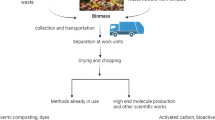Abstract
India is a religious country comprising various temples in every state which attract positive and divine vibrations from the surroundings. This study refers to Haridwar, Uttarakhand, a city full of temples (100 small and big temples) and located on the banks of the Ganga River. Pilgrimages from various states visit Haridwar. People offer flowers, rice, petals, milk, and coconut to the deities in order to fulfill their wishes, with about 100 g of flowers per person per day. Approximately 2000 people visit Haridwar during lean season. The crowd varies multifold during peak auspicious days and Chardham Yatra. It is estimated that during special occasions like Baisakhi, Purnamasi, Amavasya, Navaratri, etc., the floating population is more than 5 lakhs per day, with the largest occurring during Kavan Yatra in the rainy season, where about 1 crore people visit Haridwar and Rishikesh. Besides the temple, people also offer flowers directly to the Ganga River, which have a negative impact on the river ecology and are also a threat to living aquatic organisms. Generally, the quantity of flowers disposed of from the temple or to the river is estimated to be 10 tons/day. So far there is no strategic monitoring system and awareness among the people to dispose of the waste properly and its various reuse options. The most common flowers used for worship include lotus, roses, marigold, Hibiscus, jasmine, Parijat, and Kaner. Flowers not only are distinguished for their beauty and fragrance but also contain proteins, lipids, carbohydrates, essential oils, minerals, and vitamins and have tremendous potential for various reuse-recycle options. This study elaborates floral waste management by converting into value-added products such as dying colors, incense sticks, biofuels, perfumes, cosmetics, paper, and biofertilizers.
Similar content being viewed by others
References
Ali Esmail Al Snafi, Dept of pharmacology college of medicine University of Dhi Qar, Iraq. (Composition of flower chemical constituents, pharmacological effects and therapeutic importance of hibiscus rosa –sinensis – A review. IOSR Journal of Pharmacy. www.iosrphr.org, (e) ISSN:2250-3013, (p)-ISSN.2319-4219, Volume 8, issue 7, version II (July 2018), pp 101–119), IOSR Journal of Pharmacy, www.iosrphr.org, (e) ISSN:2250-3013, (p)-ISSN.2319-4219, Volume 8,issue 7 version II (July 2018), pp 101–119
G. Barad, A. Upadhyay, Degradation of flower wastes: A review, Department of Civil Engineering, Sarvajanik College of Engineering and Technology, Surat, Gujarat, India. Int. J. Sci. Res. Dev. (IJSRD) 4(4) (2016)., ISSN (online): 2321-0613, pp 83
V.B. Chachadi, H. Shalavadi, D. Nayak, S.H. Malekar, T.V. Teqqihalli, Quantitative analysis of floral lipids: Their role in floral fresheners and waste management. J. Adv. Sci. Res. 11(2) (2020), pp 84
F. de Lima Franzen, M.S.R. de Oliveria, H.F. Lidorio, J.F. Menegaes, L.L.M. Fries, Chemical composition of rose, sunflower and calendula flower petals for human food. Scientific and Technological research article, January–April (2019)
F.L. Franzen, N.S.P.S. Richards, M.S.R. Oliveria, F.A.A.L. Backes, J.F. Menggaes, A.P. Zago, Characterization y calidad nutricional de petalos de flores ornamentals. Acta Iguazi, Casavel 5(3), 58070 (2016)
M. Gandhi, V. Sangwan, K.K. Kapoor, N. Dilbaghi, Composting of household wastes with and without earthworms. Environ. Ecol. 15(2), 432–434 (1997)
C.K. Jha, R. Kumar, V. Kumar, D. Rajeshwari, Extraction of natural dye from marigold flower and dyeing of fabric and yarns: A focus on colorimetric analysis and fastness properties. Der Pharmacia Lett 7(1), 185–195 (2015)
P. Kaushik, V.K. Garg, Vermicomposting of mixed solid textile mill sludge and cow dung with the epigeic earthworm, Eisenia foetida. Bioresour. Technol. 90(3), 311–316 (2003)
A. Khan Ikhlas, E.A. Abourashed, Leung’s encyclopedia of common natural ingredients: used in foods, drugs and cosmetics (Wiley, Hoboken, 2010), p. 208. ISBN 9780471467434
R. Kohli, Asst professor, Civil Engineering Indore, Dr M. Hussain, HOD Civil Engineering Jalgaon, Management of Floral waste management, International Conference on Global Trends in Engineering Technology and management (2016)
R. Pasha, A. Mohands, B.R. Revathi, A novel approach in utilization of flower waste from chickballapur market towards development of value added products, project reference no 37S1018
N.D. Phuc, L.H.P. Thy, T.D. Lam, V.H. Yen, N.T.N. Lan, Extraction of jasmine essential oil by hydrodistillation method and application on formulation of natural facial cleaners. IPO Conf. Ser.: Mater. Sci. Eng. 542, 012057 (2019)
D. Sharma, K.D. Yadav, S. Kumar, Role of sawdust and cow dung on compost maturity during rotary drum composting of flowerw waste. Bioresource technology, 264–285–289 (2018)
S. Shouche, A. Pandey, P. Bhati, Study about the changes in physical parameters during vermicomposting of floral wastes. J. Environ. Res. Dev., Untapping the power of nature: essential oil extraction methods, March 20, 2017 (2011)
Q. Ye, X. Jin, X. Zhu, T. Lin, Z. Hao, Q. Yang, An efficient Extraction method for Fragrant Volatiles from Jasminum sambac (L) Ait. J. Oleo Sci. (2015). Apr 20
Author information
Authors and Affiliations
Editor information
Editors and Affiliations
Section Editor information
Rights and permissions
Copyright information
© 2021 Springer Nature Singapore Pte Ltd.
About this entry
Cite this entry
Srivastava, N. (2021). Temple Floral Waste Management in India. In: Baskar, C., Ramakrishna, S., Baskar, S., Sharma, R., Chinnappan, A., Sehrawat, R. (eds) Handbook of Solid Waste Management. Springer, Singapore. https://doi.org/10.1007/978-981-15-7525-9_37-1
Download citation
DOI: https://doi.org/10.1007/978-981-15-7525-9_37-1
Received:
Accepted:
Published:
Publisher Name: Springer, Singapore
Print ISBN: 978-981-15-7525-9
Online ISBN: 978-981-15-7525-9
eBook Packages: Springer Reference Earth and Environm. ScienceReference Module Physical and Materials ScienceReference Module Earth and Environmental Sciences




